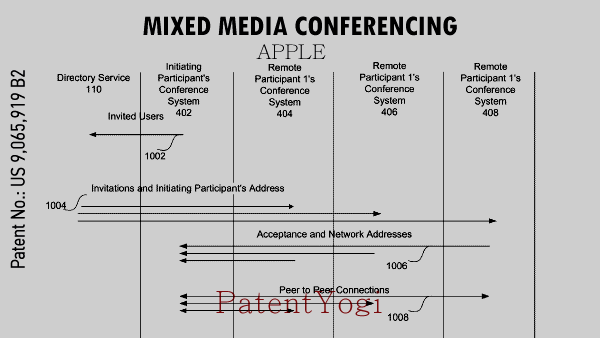Video phones has been a fantasy of humans since we invented phones.
Artist’s conception: 21st century videotelephony imagined in the early 20th century (1910).
However, the technology still does not work all the time, especially when there are multiple participants who wish to participate in a conference over a network. Anyone of has suffered due to dropped calls on Skype can appreciate this problem.
These conferences may include text, audio, video, application sharing, or some combination of the four. Frequently, the connections between the participants’ conferencing systems are established to meet a lowest common denominator–that is, if some participants have video capability but others do not, the conference does not include video for any of the participants.
Further it is difficult to add a participant to an existing conference both because the new participant may not have the minimum hardware requirements to join the existing conference.
Apple’s invention enables multiple users to participate in a multi-way conference in which each participant’s conference system communicates with the others’, and in which there is no requirement that each participant’s conference system have the same hardware capabilities. The patented communications methodology enables each participant’s conference system to take maximum advantage of its communications capability.
Upon logging in to a directory service, each user’s system makes known to the service its hardware sending and receiving capabilities, e.g., whether audio, video, text, etc., can be transmitted and/or received.
The directory service makes this information available to other users who may then wish to join a conference with the user. When a user wants to initiate a conference with multiple users, the initiating user sends invitations via the directory service to the remote users. The conference system of each user that accepts an invitation then transmits its network address (or addresses, if it has more than one) to the initiating user’s conference system, which then establishes a peer-to-peer connection with each of the remote users’ systems. Each participant system automatically exchanges information about hardware capabilities and upstream and downstream bandwidth, and one of the participants’ systems, which in one embodiment is the initiating system, is designated as a conference manager. The conference manager determines a best model for connecting each of the participants’ systems.
Patent Information:
Patent Title – Mixed media conferencing
Patent Number – 9,065,919
Inventors: Arthur; Bruce (Palo Alto, CA), van Os; Marcel (San Francisco, CA), Lemay; Stephen O. (San Francisco, CA), Christie; Gregory N. (San Jose, CA), Westen; Peter T. (Menlo Park, CA)
Assignee: Apple Inc. (Cupertino, CA)
Family ID: 1000001174276
Appl. No.: 14/275,016
Filed: May 12, 2014
Abstract – Multiple users participate in a conference while taking maximum advantage of hardware and bandwidth capabilities of each participant. Each user’s system makes known to a directory service its hardware sending and receiving capabilities. The directory service makes this information available to other users who may then wish to join a conference with the user. An initiating user sends invitations via the directory service to the remote users. Each user that accepts an invitation transmits its network address to the initiating user, who then establishes a peer-to-peer connection with each of the remote users. Each participant system exchanges information about hardware capabilities and bandwidth, and a conference manager determines a best model for connecting each of the participants. Depending on the hardware and bandwidth capabilities of the participants, the manager chooses from a duplicate streams model, a multicast model, and a host-among-peers model for connecting the participants.





